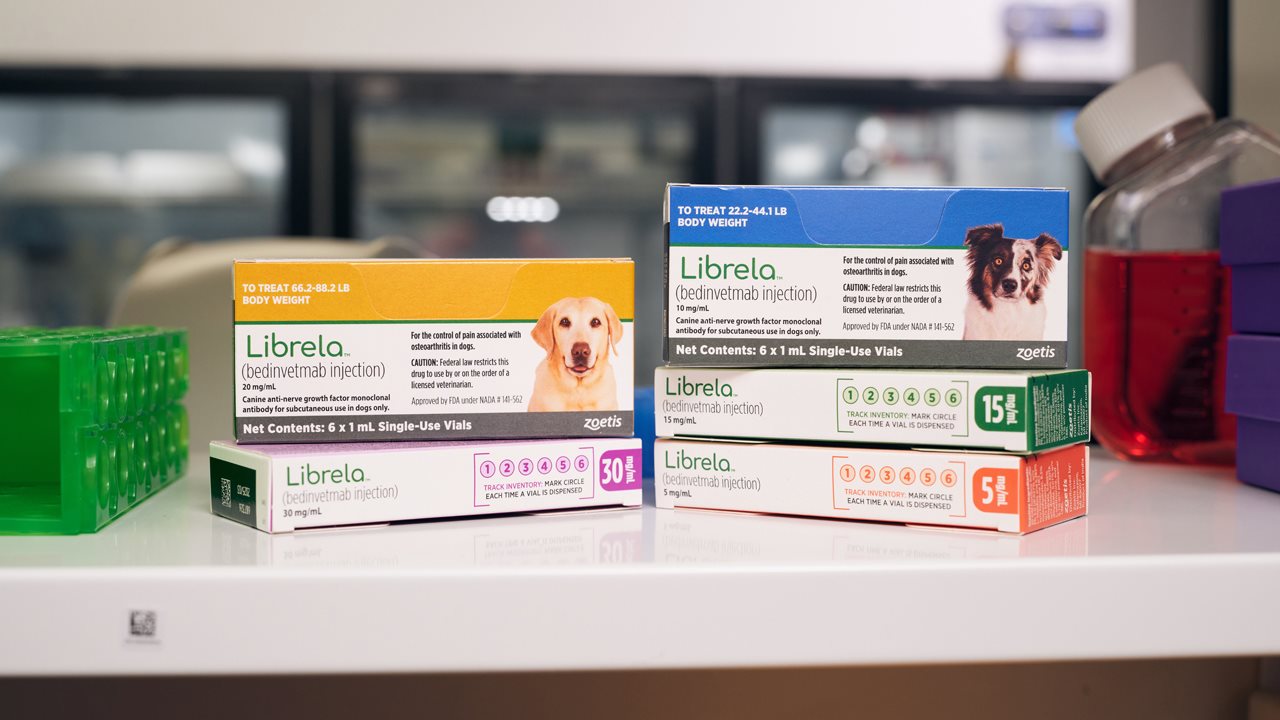(BPT) - Has your dog been acting differently? Do they seem to be slowing down? What many pet owners don't realize is that changes in behavior can also mean your four-legged friend is in pain. In fact, osteoarthritis is one of the most common causes of chronic pain in dogs.
OA is a painful condition that progresses over time. It is a degenerative disease affecting all components of the joints and eventually can lead to the joints breaking down, causing the bones to rub together. This painful condition can affect your dog's health and well-being [1], decrease their willingness to be active, and disrupt their interaction with family members, ultimately impacting the bond they share with their people. The good news is that although we cannot reverse OA, we can control the pain, which can provide your dog with an improved quality of life and get her back to being an active member of the family again.
While there is plenty of misinformation about OA and available treatment options, knowing the facts about OA pain and distinguishing between truth and myths can help provide your beloved canine companion with the care and support they need and deserve, giving them more days of play.
1. MYTH: OA pain only impacts older dogs.

FACT: Dogs of all ages, sizes and breeds can experience OA pain.[2] Signs of OA pain may be easier to detect in older dogs because they often have more advanced disease, but the pain can start at a much younger age. Dogs even as young as 1 year old can develop the condition.
In fact, approximately 40% of dogs show signs of OA pain.[3] Yet, despite its prevalence, only 33% of dogs with OA pain are diagnosed and treated for the condition.[4] It's important to identify the signs and symptoms of OA pain early to give our dogs a better quality of life.
2. MYTH: The only signs of OA pain are limping and whimpering.
FACT: While limping and whimpering are common signs of OA pain, they're not the only symptoms. Pet owners should also be on the lookout for the following signs of OA pain, including:
- Decreased activity;
- Lagging behind on walks;
- Slowness to rise;
- Hesitation or difficulty in jumping up or down;
- Stiffness;
- Difficulty going up or down stairs;
- Emotional changes, such as becoming more withdrawn or less happy and excited, or even showing signs of aggression or irritated behavior.
Pay attention to your dog's physical and emotional behaviors and share any changes with your veterinarian to help determine if these are signs of OA pain and how they can be managed. Consider recording videos of your dog too, to help your veterinarian understand the changes you are observing. Waiting until the condition becomes severe can increase the amount of pain and decrease mobility, negatively impacting a dog's physical and emotional well-being.[1] While OA cannot be cured, long-lasting relief can be provided for the chronic pain associated with OA.
By controlling OA pain, you can help your dog feel better, be more active and improve their overall quality of life.[5],[6]
3. MYTH: Available treatment options are unsafe and have not been tested.

FACT: Like other medical fields, veterinary medicine is always progressing as scientists develop innovative treatments for conditions like OA. While there are many available treatments, including monoclonal antibodies as well as non-steroidal anti-inflammatory drugs (NSAIDS), it's important to make sure that the treatment option selected for your dog is safe and effective. The best way to do that is to consult with a veterinarian.
Your dog's veterinary healthcare team can work with you on an OA pain management plan that best suits your dog and their lifestyle needs, which may include recommending a treatment like Librela® (bedinvetmab injection) to control OA pain.

Librela is the first and only FDA-approved monthly injectable monoclonal antibody therapy to control OA pain in dogs. Librela has been tested in hundreds of dogs before being approved as safe and effective for use in the United States in 2023. Additionally, Librela has been available in Europe for more than three years and has been administered to millions of dogs around the world.* [7] Librela works by controlling dogs' pain, which can lead to increased activity, which can improve quality of life, helping to restore the unique bond that dogs share with their owners.
The most common side effects of Librela in a clinical study were urinary tract infections, bacterial skin infections and dermatitis.[8]
Another option, NSAIDS have been used to treat canine OA pain for over 25 years. They also control the pain associated with osteoarthritis and are given as a once- or twice-daily oral medication. These drugs also have been approved as safe and effective. The most common side effects include appetite loss, vomiting and diarrhea, which could indicate gastrointestinal kidney or liver disease. Dogs should be evaluated for pre-existing conditions and regularly monitored.[9]
4. MYTH: Social media and online forums are the best source for pet health information.
FACT: It is natural to search for answers when your pet is sick and lean into other pet owners' experiences to help make decisions for your dog. While online platforms can be a valuable source for pet owners to gather information and advice, community experiences such as those provided by social media groups and forums are not a substitute for accurate answers from veterinary experts. It's also important to remember that each dog's experience with pain and medications are different. As professional experts with many years of education and experience, you can trust your veterinarian to offer the best advice, treatment options, and care for your dog.
All medications come with risks and it's important to talk about the risk and benefits of any treatment option with your veterinarian. They know your pet's health history and can accurately diagnose OA and determine if Librela is right for your dog.
Visit Librela.com to learn more about the signs of OA pain and how to manage your dog's care.
*Number of dogs treated estimated assuming that each dog receives 2 vials.
IMPORTANT SAFETY INFORMATION: See full LIBRELA Prescribing Information at LibrelaPI.com. For use in dogs only. Women who are pregnant, trying to conceive or breastfeeding should take extreme care to avoid self-injection. Hypersensitivity reactions, including anaphylaxis, could potentially occur with self-injection. LIBRELA should not be used in breeding, pregnant or lactating dogs. LIBRELA should not be administered to dogs with known hypersensitivity to bedinvetmab. The most common adverse events reported in a clinical study were urinary tract infections, bacterial skin infections and dermatitis.
+++
____________________________
[1] Lascelles BDX, Brown DC, Conzemius MG, Gill M, Oshinsky ML, Sharkey M. Measurement of chronic pain in companion animals: discussions from the Pain in Animals Workshop (PAW) 2017. Vet J. 2019;250:71-78. doi:10.1016/j. tvjl.2019.07.001.
[2] Anderson KL, Zulch H, O'Neill DG, Meeson RL, Collins LM. Risk factors for canine osteoarthritis and its predisposing arthropathies: a systematic review. Front Vet Sci. 2020;7:200. doi:10.3389/fvets.2020.00220
[3] IHS Markit. (2021) Canine and Feline Pain Market 2021: Animal Health Market Analysis; Wright A, et al. Identification of canine osteoarthritis using an owner-reported questionnaire and treatment monitoring using functional mobility tests. J Small Anim Pract, 2022. http://doi.org/10.1111/jsap.13500
[4] ZMR: PetTrak US Pain Factored National January 2023.
[5] Brown DC, Boston RC, Coyne JC, Farrar JT. Development and psychometric testing of an instrument designed to measure chronic pain in dogs with osteoarthritis. Am J Vet Res. 2007;68(6):631-637. doi:10.2460/ajvr.68.6.631.
[6] Brown DC, Boston RC, Coyne JC, Farrar JT. Ability of the Canine Brief Pain Inventory to detect response to treatment in dogs with osteoarthritis. J Am Vet Med Assoc. 2008;233(8):1278-1283. doi:10.2460/ javma.233.8.1278.
[7] Global pharmacovigilance data on file.
[8] Librela (bedinvetmab injection). Prescribing information. NADA 141-562. Zoetis Inc; March 2023.
[9] Monteiro, B.P., et al. 2022 WSAVA guidelines for the recognition, assessment and treatment of pain. Journal of Small Animal Practice, 2022. https://doi.org/10.1111/jsap.13566
______________________________________________________________________________
All trademarks are the property of Zoetis Services LLC or a related company or a licensor unless otherwise noted.
© 2024 Zoetis Services LLC. All rights reserved. LIB-00374





